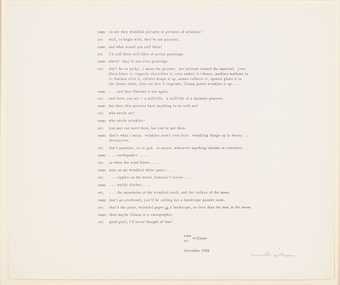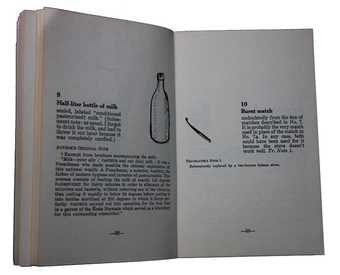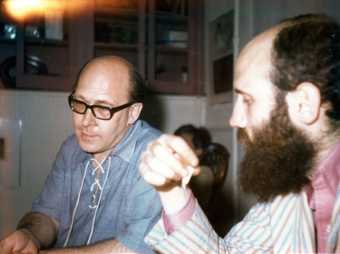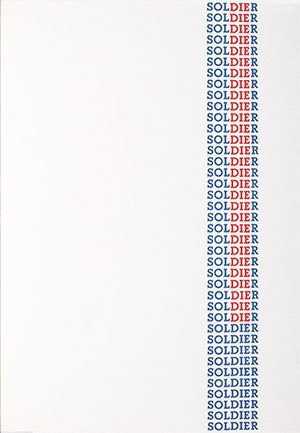
Fig.1
Emmett Williams’s interview produced as part of Liliana Porter’s Wrinkle 1968
Tate P13236
© Liliana Porter
Emmett Williams was a poet and performance artist who worked with a variety of artists, often as part of the amorphous conceptual art group Fluxus, which was named as such by the group’s founder-coordinator George Maciunas in the late 1950s. In his Fluxus activities Williams was directly involved with the works of composer La Monte Young, poet Jackson Mac Low, poet and publisher Dick Higgins and artists Joseph Beuys, Robert Filliou, Alison Knowles, Dieter Roth and Jean Tinguely, among many others. In December 1968 Williams collaborated with Liliana Porter on her portfolio of photo-etchings entitled Wrinkle (Tate P13236). His part in the collaboration took the form of a mock interview in which he and his invented interlocutor (‘emm’ and ‘ett’) addressed aspects of this specific artwork by Porter (fig.1). Her artwork reflected an array of themes and ideas that Williams brought to the fore through his own practice and those he had experienced in the works of others.
Fluxus and freedom
In the interview Williams uses humour and mock seriousness with an underlying serious intent in a way that is characteristic of Fluxus performance. His participation in Fluxus group activities and collaborative projects started in the late 1950s. Maciunas proposed Fluxus as a complex of different approaches to art, music and poetic practice, evident before this in the work of Marcel Duchamp. These involved chance operations, influenced by Duchamp and composer John Cage, for example in the first ‘happening’,1 and the ideas of gesture proposed by writer Antonin Artaud.2 In the mock interview in Wrinkle Williams’s interlocutor notes a range of different approaches to the traditional form of canvas painting, including those of Roth and Daniel Spoerri, both of whom Williams had collaborated with (‘spoerri glues it to the dinner table, diter rot [sic] lets it vegetate’).
For Williams ‘Fluxus simply provided a forum, free from the entanglements of the art establishment’, in which many artists could demonstrate their works in the company of kindred spirits.3 There was no aesthetic to unite these musical, theatrical and poetic activities in a common cause, other than that they were all meeting at the same events and sharing publishing houses and publications. In light of this it can be recognised that Porter’s openness and innovation, evident from this collaboration with Williams and her work elsewhere, gave her an affinity with a variety of artistic practices. As Williams noted, Joseph Beuys saw Fluxus as an art movement that had, in Beuys’s words,
a very open relationship to life … that totally separated itself from all the aesthetic categories of the past. They were interested in emphasising and animating all the spheres of human thought, and especially with respect to creativity … The importance of our relationship – and this was the fundamental motivation of the entirety of the Fluxus movement – lay in the way we were involved in developing something for the future, something that was directly connected to human society … The form that Fluxus was trying to promote was first of all a form of openness.4
In response to Williams’s interview question, ‘so are they wrinkled pictures or pictures of wrinkles?’, the interlocutor replies, ‘well, to begin with, they’re not pictures’, but rather it is ‘the gesture, her attitude towards the material’ that brings about the artwork.
This shift of genres and practices was evident elsewhere in Fluxus activities. For example, what attracted artist Wolf Vostell to Fluxus ‘was the variety of its musical aesthetic, its way of looking at things that went from action music, to life music, thought music, de-collage music, and behaviour music, and finally right down to invisible music. It was a spectrum that did more than just think of life as a work of art’. This mirrors something Williams had said in 1961: ‘Life is a work of art, and the work of art is life’.5 For Williams:
Fluxus … must be simple, amusing, unpretentious, concerned with insignificances, require no skill or countless rehearsals, have no commodity or institutional value … Fluxus art-amusement is the rear-guard … It strives for the mono structural and non-theatrical qualities of simple natural events, a game or a gag. It is the fusion of Spike Jones, vaudeville, gag, children’s games and Duchamp … obtainable by all and eventually produced by all.6
As Williams subsequently also notes, in the spirit of Duchamp and perhaps Beuys, ‘Maciunas explored the possibility of printing all Fluxus publications in inks that would disappear, and on paper that would disintegrate in a few years.’7 The association with Porter’s Wrinkle and with Williams’s collaboration becomes quickly evident again in terms of this unpretentiousness. However, perhaps counter to Fluxus activity, Porter’s work retains a significant attention to visual effects and was made in a way that has allowed it to survive as a material object.

Fig.2
Spread from Daniel Spoerri’s An Anecdoted Topography of Chance, published in New York in 1966
In 1966 Williams’s profile came to the fore when he was made editor-in-chief of Dick Higgins’s newly founded Something Else Press in New York. Work commenced on publishing Jefferson’s Birthday back-to-back with Postface, both written by Dick Higgins. That year Something Else Press published An Anecdoted Topography of Chance by Spoerri (fig.2). For this Spoerri created a map of objects that happened to be lying on a table in his home, wrote a scientific description of each, and then added personal memories and anecdotes connected with the items, written by Robert Filliou, Williams, Roth and Roland Topor.8 Alongside his literary and publishing activities, Williams’s residence in New York gave him the opportunity to increase his collaborative public performances. His first performance in the US was in February 1966 with his poem The Ultimate Poem or An Exile Returns. Williams performed in St Mark’s, New York, with composer Philip Corner and painter Tom Wasmuth. They improvised on the text of The Ultimate Poem and then others joined in, including poets Paul Blackburn and Jerome Rothenberg, musician and artist Max Neuhaus, and artists Al Hansen, Ray Johnson, Marta Minujin, Nam June Paik and Carolee Schneemann.
In a further activity, Williams performed his poem Synonomy with Paik and artist-musician Charlotte Moorman at the Cinematheque in New York in 1966. After the performance he embedded the plastic animal letters, together with a plastic container of synthetic diseased urine packaged by the US military, in concrete to create Life and Letters 1966 (location unknown). This was the first visual work he made after his return to the United States in 1966. He took the original to Reykjavik in 1967 and gave it to the artist Dieter Roth in exchange for one of the latter’s sculptures. Roth made a drawing of the original work, also called Life and Letters.9
Collaborating on Wrinkle
Williams’s collaboration with Porter came about in 1968 from the happenstance typical of artistic collaborations of the period. Williams had been invited to participate in an international artists’ seminar at Fairleigh Dickinson University, New Jersey.

Fig.3
Emmett Williams (left) with underground filmmaker Jud Yalkut at Liliana Porter’s home in Morristown, New Jersey, 1968
© Liliana Porter. Courtesy the artist
Porter and Uruguayan artist Luis Camnitzer had printing facilities in their studio in Morristown, New Jersey, and they took the opportunity of Williams’s presence in the locality to invite him to make etchings at the studio (fig.3). He factured two works, one in collaboration with fellow Fluxus artist Ay-O.10 It was on this occasion that Porter invited Williams to write the text for her series of photo-etchings Wrinkle. Williams’s text, the ‘interview’ with himself, was then included as an integral part of Wrinkle.11
Williams’s collaboration with Porter is part of a range of artistic activities that he undertook in America. In 1970 Williams’s poem SOLDIER appeared in the form of a silkscreen print in red and blue. The printed text is composed entirely of the word ‘soldier’ in a variety of graphic configurations. It has all the joy and play that exemplifies Williams’s practice and shows a strong affinity with Porter’s Wrinkle in its progressive transformation of a developing configuration of forms.
Despite Williams’s commitment to producing visual art, in a 1976 interview the critic Jan Herman asked him to agree that he was ‘a poet before anything else’. Williams answered, ‘I agree, with a few reservations. The “anything else” bothers me.’ Herman pursued the question through a variety of exchanges. What this led to was a recognition that there is a continual shift in genres. Regarding Williams’s Alphabet Symphony 1962 (Museum of Modern Art, New York) Herman said, ‘What interests me is that you call it a poem, and not a Happening.’ Williams replied, ‘I call it a symphony, though it’s a poem, of course. A poem that gets off the page.’ Williams recalled someone asking Roth during his retrospective at the Hayward Gallery in London ‘why he made such “awful” pictures, and he said something like “I don’t know why, but sometimes I wish I didn’t have to.”’ Harman responded, ‘And you feel compelled to make pictures too. Why does a poet make pictures?’. Williams replied, ‘Something Kandinsky said years ago about his own poems is as good an answer as I could give you, to the effect that poetry was simply a changement d’instrument, and that the driving force behind all his work – paintings or poems – remained always the same.’12
One of the other associations with Williams’s work has been the practice of Zen Buddhism. This again links to John Cage and the latter’s studentship with Buddhist writer Daisetsu Teitaro Suzuki, but as Williams noted, Cage was not a Zen missionary but an artist and teacher who also ‘studied’ with Duchamp, composer Arnold Schoenberg and architect and inventor Buckminster Fuller. Williams also makes a link with European philosophical ideas. A good case, Williams noted, ‘could be made for interpreting the flux in Fluxus as Hegel’s “Primary Truth”’, straight out of Heraclitus, that everything in nature is in continuous flux, and that ‘struggle is the father of everything’.13 In Porter’s work Williams identifies aspects of these ideas. In the interview that forms part of Wrinkle, Williams says, ‘you’ll be calling her a landscape painter soon’. The interlocutor replies, ‘that’s the point, wrinkled paper is a landscape, no less than the man in the moon’.

Fig.4
Page from the 2014 edition of Emmett Williams’s poem SOLDIER 1970
© Estate of Emmett Williams
Throughout his artistic career Williams used the techniques of concrete poetry, which he characterised as ‘a return to the poem as picture’.14 This involved the repetition and variation of words and shapes. For the practitioners of the 1950s, Williams observes, ‘The visual element in their poetry tended to be structural, a consequence of the poem, a “picture” of the lines of force of the work itself, and not merely textual’; it used ‘the semantic, visual and phonetic elements of language as raw materials in a way seldom used by the poets of the past’.15 In his collaboration with Porter, Williams identifies the edges of the transforming shape of the canvas as it develops in space and across time. Towards the end of the Wrinkle interview Williams says, ‘then maybe liliana is a cartographer’; ‘good grief!’, replies his interlocutor, ‘i’d never thought of that!’.
A printing of Williams’s 1970 poem SOLDIER appeared in book form in 2014.16 Opening with the word ‘SOLDIER’ printed repeatedly in blue in a long list down the page, on successive pages the letters ‘DIE’ within the word ‘SOLDIER’ begin to become inked in red, moving down the list until on the last page all of the words feature ‘DIE’ in red (see fig.4 for a reproduction of one of the pages). What begins with simplicity and clarity shifts through a rhetorical complexity into a straightforward statement. Although Williams’s SOLDIER is a very different artwork to Porter’s Wrinkle, these works and their associated practices, in this case in their use of successive visual transformations, demonstrate a strong conceptual parity.
